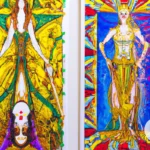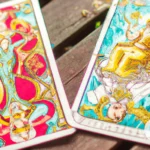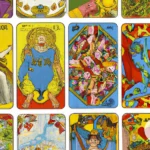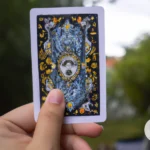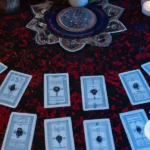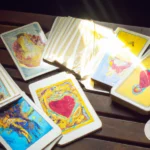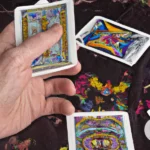As we wander through life, seeking answers to the myriad of questions that plague our minds, we often turn to unconventional methods in attempts to understand the world around us. Tarot cards have been a popular tool for divination and introspection for centuries, offering insight and guidance to those who seek it. However, with so many different tarot decks available on the market, choosing the right one can be a daunting task. In this guide, we’ll take a deep dive into the world of tarot and compare the popular Rider-Waite Tarot Deck with other options available. By the end of this article, you’ll have a better understanding of the deck that is right for you and your tarot reading goals.
Kickstarting Your Tarot Journey: What Is a Tarot Deck?

Tarot is a popular tool used for divination and understanding one’s inner self. It consists of a deck of cards, each with its unique meanings and symbolism. Tarot cards are often used for readings that help people gain insight into their lives, make decisions, and find direction.
The Rider-Waite Tarot deck is one of the most well-known and widely used decks in the world. It features seventy-eight cards, including twenty-two Major Arcana cards and fifty-six Minor Arcana cards. The Major Arcana represents significant life events and experiences, while the Minor Arcana offers insight into day-to-day situations and minor events.
But the Rider-Waite Tarot deck is not the only tarot deck available on the market. There are many other popular decks to choose from, each with its unique artwork, symbolism, and meanings. Some popular decks include the Thoth Tarot, the Marseille Tarot, and the Wild Unknown Tarot.
When selecting a Tarot deck, it’s important to consider its artwork, symbolism, and meanings. Some decks may have more vibrant colors, while others may have a darker, more muted palette. Additionally, some decks may have more traditional imagery, while others may have more abstract or unconventional representations of the cards’ meanings.
It’s also important to consider the price range and how the deck feels in your hands. Some decks may be more expensive, while others may be more affordable. You want to select a deck that feels comfortable and easy to handle.
Before choosing a tarot deck, you should set your tarot reading goals and consider your personal aesthetics preferences. If you are looking to start reading tarot, the Rider-Waite Tarot deck is an excellent choice. It provides an excellent foundation for learning the symbolism and meanings of the cards. Additionally, there are many resources available that explore the history, symbolism, and meanings of the Rider-Waite Tarot deck, such as /rider-waite-tarot-history/, that can help you get started.
To cleanse and protect your Rider-Waite Tarot deck, there are different methods you can use, like those discussed in /cleanse-protect-rider-waite-tarot-deck/. These methods are designed to keep your cards energetically clean and protect them from negative energies.
Tarot is a powerful tool that can help you understand yourself and your life better. By selecting the right deck and practicing tarot reading, you can open yourself up to a world of self-discovery and growth.
What Is the Rider-Waite Tarot Deck?
As you begin to dive into the world of tarot, one of the most recognizable and widely used tarot decks is the Rider-Waite Tarot Deck. Developed in the early 20th century by A. E. Waite with illustrations by Pamela Colman Smith, this deck consists of 78 cards divided into the Major Arcana and Minor Arcana. The Major Arcana includes 22 cards, while the Minor Arcana includes 56 cards divided into four suits. The Rider-Waite Tarot Deck has become a foundational deck for tarot readers, often used as a reference point for comparing other decks. In the following sections, we’ll take a closer look at what sets the Rider-Waite Tarot Deck apart and how it compares to other popular decks. For further exploration of the Rider-Waite Tarot Deck, check out our guides on the Major Arcana cards, Minor Arcana, symbolism, and tips for reading with this deck.
What Are Other Popular Tarot Decks?
When it comes to choosing a tarot deck, there are numerous options available in the market. While Rider-Waite Tarot Deck is undeniably the most popular one, there are other tarot decks that are just as famous. Here are some of the other popular tarot decks:
- The Thoth Tarot Deck: Designed by Aleister Crowley, an English occultist and writer, The Thoth Tarot Deck is a visual masterpiece that combines Egyptian symbolism and Hermetic principles.
- The Marseille Tarot Deck: One of the oldest tarot decks still in use, The Marseille Tarot Deck has a distinct style that originated in 18th century France. It features simple, yet elegant, artwork and focuses exclusively on the major arcana.
- The Shadowscapes Tarot: A relatively new addition to the world of tarot, The Shadowscapes Tarot is a modern and visually stunning deck created by Stephanie Pui-Mun Law. It incorporates fantasy elements and features vibrant colors that make it stand out from traditional tarot decks.
- The Wild Unknown Tarot: Created by artist Kim Krans, The Wild Unknown Tarot features simplistic and minimalist artwork that adds a touch of modernity to the traditional tarot deck. It is often praised by beginners for its clear and straightforward symbolism.
- The Gilded Tarot: A visually striking deck with opulent and ornate imagery, The Gilded Tarot deck is a modern reimagining of the Rider-Waite deck. It is often recommended for those who are drawn to the Rider-Waite deck but prefer a more modern aesthetic.
Each of these tarot decks has its unique characteristics that make it stand out from the rest. It is important to explore different options before deciding on a tarot deck as it can significantly affect the quality and accuracy of your readings.
Comparing the Rider-Waite Tarot Deck with Other Popular Tarot Decks
When it comes to tarot decks, the Rider-Waite deck is often considered the gold standard. However, there are also many other popular tarot decks to choose from. If you’re looking to compare the Rider-Waite deck with other options, there are a few key factors to consider.
Differences in Major Arcana Cards
One of the primary differences between tarot decks is often in the Major Arcana cards. While the basic concepts of the cards are generally the same from deck to deck, the artwork and interpretation can vary widely. For example, the Thoth deck, designed by Aleister Crowley, has somewhat darker imagery and interpretations than the Rider-Waite deck. The Osho Zen deck, on the other hand, incorporates more Eastern philosophy and imagery into the Major Arcana cards.
Differences in Minor Arcana Cards
The Minor Arcana cards also have variations between decks. Some decks, like the Marseille deck, have relatively simple designs and rely heavily on numerology in their interpretations. Other decks, like the Wild Unknown deck, have more complex and artistic designs that may require a bit more exploration to fully uncover their meanings.
Differences in Deck Imagery and Artwork
Aside from the differences in individual cards, the overall style and artwork of each deck can also vary greatly. Some decks, like the Deviant Moon deck, have a darker, more Gothic feel to them. The Illuminati Tarot, meanwhile, has more futuristic, almost science-fiction-like imagery.
All of these differences can have an impact on the overall feel and energy of a reading. While some people may prefer a more traditional and straightforward approach, others may find that a deck with more unique and creative artwork helps them tap into their intuition more easily.
Choosing the Right Tarot Deck for You
Ultimately, choosing the right tarot deck comes down to your own personal preferences and goals. Some important factors to consider when selecting a deck include:
Identify Your Tarot Reading Goals
Think about what you hope to achieve with your tarot practice. Are you looking to gain insight into your daily life, explore your spiritual path, or make important decisions? Make sure the deck you choose aligns with your goals.
Consider Your Personal Aesthetic Preferences
Take a look at different tarot decks online or in a metaphysical shop and see what stands out to you. Do you prefer more traditional artwork, or are you drawn to more modern or abstract designs?
Think About Your Tarot Price Range
Some tarot decks can be quite pricey, so make sure you’re comfortable with the cost before making a purchase. Keep in mind that the cost of the deck may impact how you feel about it and how frequently you use it.
Research Your Options
Take the time to read reviews of different decks and see what others have to say about their experiences with them. You can also ask for recommendations from friends or other practitioners.
Handling Your Deck
Consider how the deck feels in your hands – is it comfortable to shuffle and handle? Do the cards feel sturdy and durable? You’ll likely be using your deck quite a bit, so it’s important to choose one that you feel physically comfortable with.
Remember, there is no right or wrong answer when it comes to choosing a tarot deck. Ultimately, the deck that resonates with you the most is the one that will likely yield the most accurate and meaningful readings.
Differences in Major Arcana Cards
When delving into the world of tarot, it’s essential to understand the differences between popular tarot decks to find the one that resonates with you the most. One of the key components of a tarot deck is the Major Arcana cards, each one representing a significant archetypal theme. The imagery and symbolism used in these cards can vary greatly from deck to deck, altering the entire meaning and interpretation of a reading. Exploring the differences in the Major Arcana cards between decks is crucial in choosing the right one to suit your unique perspective and goals. So, let’s take a closer look at how the Major Arcana cards differ in various tarot decks.
Differences in Minor Arcana Cards
When it comes to comparing different tarot decks, the minor arcana cards also hold importance. These cards may not have as significant an impact as major arcana cards, but they are still essential in providing insights into your daily life.
Numbering and Naming Convention: The Rider-Waite deck set the standard for numbering and naming the cards of minor arcana among most current tarot deck designs. Many modern decks follow their examples with slight variation in iconography and imagery.
Illustrations: The illustrations on minor arcana cards often vary significantly across different decks. While some decks feature realistic imagery, others may feature abstract imagery or simple geometry symbols.
Suit Symbolism: The symbolism of the suits can vary across different tarot decks. While Rider-Waite uses the conventional cups, wands, swords, and pentacles found in many decks, some decks may choose to use different suits such as feathers, crystals, or flowers.
Court Cards: The court cards often represent characters, personalities, or archetypes. In Rider-Waite tarot, the court cards are traditionally named page, knight, queen, and king. However, some modern decks replace these with alternative naming conventions such as daughter, son, mother, and father.
Reversed Interpretations: While most tarot decks have upright and reversed interpretations, the meanings of reversed positions may vary across different decks. It’s essential to familiarize yourself with the meanings of the cards in your chosen deck to avoid any confusion during readings.
The minor arcana cards are an important aspect of tarot readings, and choosing the right deck depends on your personal preferences towards illustrations, symbolism, and naming conventions. It’s crucial to explore different decks and choose the one that resonates the most with you to make your tarot reading experience more fulfilling.
Differences in Deck Imagery and Artwork
When it comes to the imagery and artwork of tarot decks, there can be significant variations that can impact the overall experience and interpretation while using the cards for readings. Different decks draw on specific themes and artistic styles to bring forth unique interpretations of the tarot.
Let’s take a look at some of the differences in deck imagery and artwork between the Rider-Waite Tarot Deck and other popular decks:
| Deck Name | Imagery and Artwork |
|---|---|
| Thoth Tarot Deck | The Thoth Tarot Deck features more intricate and esoteric imagery, with a vivid colorscheme and detailed symbolism designed to stimulate the subconscious mind. |
| Aleister Crowley Tarot Deck | The artwork of the Aleister Crowley Tarot Deck features bold, abstract interpretations with a strong focus on astrological symbolism and occult philosophy. |
| Tarot of Marseilles | The Tarot of Marseilles features traditional medieval artwork with muted colors and minimal shading, emphasizing the simplicity and directness of the tarot archetypes. |
| Wild Unknown Tarot Deck | The Wild Unknown Tarot Deck features minimalist black-and-white illustrations of animals and natural elements, with a focus on earthy, grounded energy and spiritual connection to nature. |
| Universal Waite Tarot Deck | The imagery of the Universal Waite Tarot Deck is very similar to the Rider-Waite Tarot Deck, but with more vibrant colors and smoother shading, giving the cards a softer, more dreamlike quality. |
As we can see, each deck brings its own unique visual style and artistic interpretations to the table which can impact how the images resonate with the reader and the querent. It’s important to consider your aesthetic preferences when choosing a deck, as you’ll be spending a significant amount of time working with the cards.
However, it’s also important to note that while there may be differences in the artwork across decks, the meanings and interpretations of the tarot archetypes remain relatively consistent. Ultimately, it’s up to the reader to connect with the imagery and tap into their intuition to fully harness the power of the tarot.
Choosing the Right Tarot Deck for You
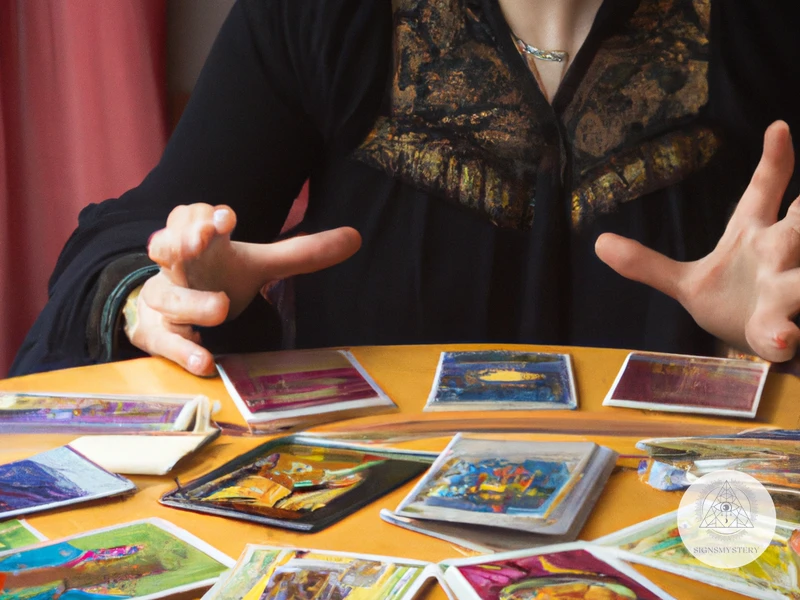
Identify Your Tarot Reading Goals
Before deciding on a tarot deck, it’s important to identify your tarot reading goals. Are you interested in using tarot for divination or personal reflection? Do you want a deck that focuses on love and relationships, or one that covers a broad range of life topics? Determining your goals can help you narrow down your options and find a deck that suits your specific needs.
Consider Your Personal Aesthetic Preferences
Tarot decks come in a variety of styles and designs, from traditional to modern, whimsical to abstract. Consider what type of artwork and aesthetic appeals to you. Do you prefer bright, bold colors or subdued, muted tones? Do you like highly detailed, realistic images or more abstract, symbolic designs? Finding a deck that resonates with your personal aesthetic can make your tarot practice more enjoyable and intuitive.
Think About Your Tarot Price Range
Tarot decks can range in price from a few dollars to hundreds of dollars. Consider how much you are willing to spend on a deck. Keep in mind that higher price doesn’t always mean higher quality. There are many excellent decks available at affordable prices. However, if you are looking for a collector’s item or a rare deck, you may need to be prepared to shell out more money.
Research Your Options
With so many tarot decks available, it can be overwhelming to choose the right one. Research different decks online or visit your local metaphysical store to see them in person. Look for reviews, images, and descriptions of the deck to get a feel for its style, symbolism, and energy. You may also want to consider purchasing a deck that comes with a guidebook or instruction manual to help you get started.
Handling Your Deck
Before making a final decision on a tarot deck, consider how comfortable you are handling the cards. Some decks may be smaller or larger than others, or have a different feel to the cardstock. Handling the cards can be an important part of building a connection with your deck, so choose one that feels natural and easy to use.
What’s Right for You?
Choosing the right tarot deck is a personal decision that depends on your individual preferences, goals, and budget. Take the time to explore your options, do your research, and trust your intuition when selecting a deck. With the right deck, you can begin a meaningful and transformative journey into the world of tarot.
Conclusion
Whether you are a seasoned tarot reader or just starting out, choosing the right deck is an important part of your tarot practice. By considering your tarot reading goals, personal aesthetic preferences, budget, and level of comfort with handling the cards, you can find a deck that resonates with you and helps you unlock the wisdom and insight of the tarot.
Identify Your Tarot Reading Goals
When it comes to choosing the right tarot deck, one of the most important factors to consider is identifying your tarot reading goals. What do you hope to gain from using tarot cards? Do you want to use them for personal growth and introspection, or for divination and fortune-telling? Understanding your goals will help you narrow down your search and find a deck that aligns with your specific needs. Keep in mind that different decks may be better suited for different purposes, so taking the time to reflect on your intentions is an essential first step in the process.
Consider Your Personal Aesthetic Preferences
When it comes to choosing a tarot deck, your personal aesthetic preferences can play a significant role in your decision-making process. Tarot decks come in a variety of artistic styles and designs, and finding one that speaks to your personal taste can enhance your connection to the cards and your readings.
Consider the Art Style
One of the most important aspects of a tarot deck’s aesthetic is its art style. Some decks feature more traditional art styles, with intricate drawings and detailed illustrations. Others may have a more modern or abstract look, with bold, graphic designs that use color and
Subscribe to Our Newsletter
Sign up to receive the latest news and updates.
To help you determine which art style resonates most with you, create a table with two columns: one labeled “traditional” and the other labeled “modern.” Under each column, list the tarot decks that fall within that category, along with a brief description of each deck’s art style. Take your time to examine the decks and compare their different styles, and think about how you respond emotionally to each one.
Consider the Color Scheme
Another important aspect of a tarot deck’s aesthetic is its color scheme. Some decks use bright, bold colors in eye-catching combinations, while others opt for muted or monochromatic palettes. Some decks also make use of metallic foils or embossing, which can add to the deck’s visual appeal.
To consider your color preferences, make another table with two columns: one labeled “bright” and the other labeled “muted.” Under each column, list the tarot decks that fall within that category, along with a brief description of their color scheme. Think about which colors catch your eye and which ones you find appealing or soothing.
Consider the Size and Texture
In addition to the art style and color scheme, the size and texture of the tarot deck can also affect its aesthetic appeal. Some decks are smaller and more portable, with smooth or shiny cardstock that feels sleek in your hands. Other decks may be larger and heavier, with a rough or matte texture that feels more substantial.
To help you determine your size and texture preferences, create a third table with two columns: one labeled “small and smooth” and the other labeled “large and rough.” Under each column, list the tarot decks that fit within that category, along with a brief description of their size and texture.
In the end, your personal aesthetic preferences will likely play a major role in your decision to choose a particular tarot deck. By taking the time to examine and compare different decks based on their art style, color scheme, size, and texture, you can find the one that speaks most powerfully to you and enhances your own unique tarot journey.
Think About Your Tarot Price Range
When it comes to selecting a tarot deck, the price range is an important factor to consider. Some decks can be quite expensive, while others are more affordable. Before deciding on a deck, take some time to think about your budget and how much you are willing to spend.
| Tarot Deck | Price Range |
|---|---|
| Rider-Waite Tarot Deck | $15 to $25 |
| Thoth Tarot Deck | $25 to $40 |
| Aleister Crowley’s Thelemic Deck | $30 to $45 |
| Tarot of the Cat People | $20 to $30 |
| Golden Tarot | $30 to $50 |
Remember, the price of a tarot deck does not necessarily indicate its quality or effectiveness in readings. It is possible to find a deck that suits your needs and budget. Additionally, keep in mind that some decks may come with supplementary materials, such as guidebooks or digital apps, that can affect the overall cost. It may also be worth considering purchasing a beginner’s kit that includes not only the deck but also instruction manuals, spreadsheets, and other crucial components for starting your tarot journey. Ultimately, it is up to you to determine how much you are willing to spend on your tarot deck and what features are most important to you.
Research Your Options
When choosing a tarot deck, it is important to research your options thoroughly to find a deck that aligns with your needs and preferences. To make the research process easier, it can be helpful to create a table to compare different deck options side by side.
In the table, you can include important details such as the deck name, author, artist, number of cards, and card dimensions. You can also include any unique features or symbolism that sets the deck apart from others.
Online reviews and recommendations can also provide valuable insight into the quality and usability of different tarot decks. Popular online retailers such as Amazon and Etsy often have customer reviews and photos to help you get a better idea of the deck before purchasing.
Additionally, attending a local tarot meetup or class can provide an opportunity to see different decks in person and even try them out before making a purchase. You can also ask fellow tarot enthusiasts for their recommendations and experiences with different decks.
Remember to keep your tarot reading goals, personal aesthetic preferences, and budget in mind when researching your options. By taking the time to carefully research and compare different tarot decks, you can find a deck that resonates with you and enhances your tarot journey.
Handling Your Deck
One important factor to consider when choosing a tarot deck is how it feels in your hands and how easy it is to handle. The size, weight, and texture of a deck may affect your ability to shuffle, draw cards, and connect with the imagery.
Size: The size of a tarot deck can vary greatly. Some people prefer a smaller deck that can fit easily in their hands and be shuffled easily. Others may prefer a larger deck with more detailed artwork that can be used for meditation and study. It ultimately comes down to personal preference and what feels comfortable for you.
Weight: The weight of a tarot deck can also affect how easy it is to handle. Some decks may be thicker and heavier, which can make shuffling and holding the cards more difficult. On the other hand, a lighter deck may not feel as substantial and may be more prone to damage.
Texture: The texture of a tarot deck can also play a role in its handling. Some decks may have a smoother finish, which can make shuffling easier, while others may have a more textured finish that can provide more grip. Again, this ultimately comes down to personal preference.
It’s important to handle a deck before purchasing it to make sure it feels right for you. If you’re purchasing online, look for reviews and photos that can give you a sense of the deck’s size, weight, and texture.
Once you have a deck, it’s important to take care of it to maintain its condition and energy. Some tips for handling your deck include:
| Tips for Handling Your Deck |
|---|
| 1. Store your deck in a safe and sacred place. |
| 2. Avoid exposing your deck to extreme temperatures, moisture, or direct sunlight. |
| 3. Keep your deck in its box or bag when not in use to protect it from damage and energy contamination. |
| 4. Use a consistent and respectful shuffling technique to help build a connection with your deck. |
| 5. Consider cleansing your deck before and after each use to clear any lingering energies. |
Remember to treat your tarot deck as a sacred tool and it will serve you well in your journey towards self-discovery and divination.
What’s Right for You?
Ultimately, choosing the right tarot deck for you comes down to personal preference and your individual goals for using the deck. It can be overwhelming to navigate the vast array of options available on the market. However, with a little self-reflection and research, you can find the perfect deck to support your tarot journey.
When considering which deck is best for you, start by identifying your tarot reading goals. Are you looking to use tarot as a tool for self-reflection and personal growth, or are you interested in using it to give readings for others? Different decks lend themselves better to different reading styles, so it’s important to choose one that aligns with your intentions.
You should also consider your personal aesthetic preferences. Tarot decks come in an array of styles, from traditional to modern, and feature a variety of artwork and imagery. Some decks feature illustrations with bold colors and sharp lines, while others may have softer, more ethereal artwork. It’s important to choose a deck that resonates with you visually and aligns with your personal taste.
Price range is also an important factor to consider. Tarot decks can range from under ten dollars to well over one hundred, depending on the quality and complexity of the cards. Consider how much you’re willing to invest in your tarot practice, but also keep in mind that a higher price tag doesn’t always mean a better deck.
Researching your options is crucial, as it can help you get a sense of the different decks available and what each one offers. Look up reviews, flip through images of the deck, and see if you can find any samples of its card meanings or interpretations. This can help you get a sense of the deck’s energy and whether it aligns with your intentions.
Finally, it’s important to consider how you’ll handle your deck. Tarot cards are a tool for intuitive guidance and can be influenced by your energy and intention. Some people prefer to wrap their deck in a cloth when not in use, while others store them in a special box or case. Consider how you’ll treat your deck and what kind of energy you want to infuse into it.
Remember, there’s no right or wrong choice when it comes to selecting a tarot deck. Trust your intuition and choose a deck that speaks to you. With the right deck, you can open the door to meaningful insights, self-reflection, and spiritual growth.
Conclusion
In conclusion, it’s important to remember that choosing a tarot deck is a personal decision that should be based on your individual needs and preferences. The Rider-Waite tarot deck may be the most popular and widely used deck, but it’s not the only option available. Other decks, such as the Thoth tarot deck or the Marseille tarot deck, offer unique interpretations and imagery that may resonate more with you.
When comparing tarot decks, it’s important to consider the differences in major and minor arcana cards, deck imagery, and artwork. These differences may seem small, but they can greatly affect the way you connect with and interpret the cards.
In addition to these factors, it’s important to also consider your tarot reading goals, personal aesthetic preferences, and budget when choosing a deck. It may be helpful to do some research and handle different decks before making a decision.
Ultimately, the most important thing is to choose a tarot deck that feels right for you and that you feel a connection with. The tarot can be a powerful tool for self-discovery and guidance, and the right deck can enhance this experience. So take your time, explore your options, and trust your intuition when making your decision.
Frequently Asked Questions
What is the meaning of “Tarot Deck”?
A tarot deck is a set of 78 cards, each with its own unique imagery, symbolism, and meaning, that is used for divination, insight, guidance, and reflection.
What is the Rider-Waite Tarot Deck?
The Rider-Waite Tarot Deck is a famous and influential deck that was first published in 1909. It features detailed and expressive artwork by Pamela Colman Smith, and is known for its rich symbolism and archetypal imagery.
What are some other popular Tarot Decks?
Some other popular Tarot Decks include the Thoth Tarot Deck, the Marseille Tarot Deck, the Wild Unknown Tarot Deck, and the Golden Tarot Deck.
What are the differences between the Major Arcana cards in different Tarot Decks?
The Major Arcana cards in different Tarot Decks can vary in their imagery, symbolism, and interpretation. Some decks may have different names for certain cards, or feature different aspects of the same archetypes.
What are the differences between the Minor Arcana cards in different Tarot Decks?
The Minor Arcana cards in different Tarot Decks can vary in their suits, their Court Cards, their imagery, and their color schemes. Some decks may use different names for the suits or have different depictions of the same elements.
What are the differences in deck imagery and artwork?
Deck imagery and artwork can vary greatly between different Tarot Decks, depending on the artist’s style and the deck’s overall theme. Some decks may have bold and colorful designs, while others may be more minimalist or traditional in their depictions.
How do I choose the right Tarot Deck for me?
Choosing the right Tarot Deck involves considering your tarot reading goals, personal aesthetic preferences, budget, and research into different deck options. It’s also important to handle and connect with the deck before making a final decision.
How do I identify my Tarot reading goals?
Identifying your Tarot reading goals involves reflecting on what you hope to gain from your tarot practice, whether it be insight, guidance, personal growth, or divination. Different decks may have different strengths in certain areas.
How do I handle my Tarot Deck?
Handling your Tarot Deck involves shuffling the cards, cleansing them of any negative energy, and connecting with them on a personal level. This can involve holding them or sleeping with them under your pillow to create a stronger bond.
What is the best Tarot Deck for beginners?
The Rider-Waite Tarot Deck is often recommended as a good deck for beginners due to its clear and straightforward imagery, as well as its popularity and availability. However, ultimately the best deck for a beginner will depend on personal preferences and goals.



